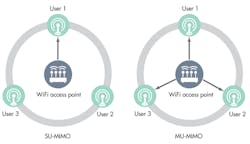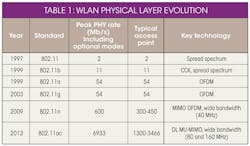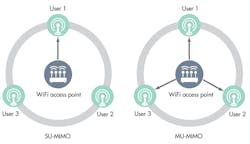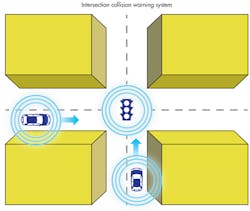This file type includes high resolution graphics and schematics when applicable.
Wireless-local-area-networks (WLANs) based on WiFi technology have become a standard part of life for many, whether integrated within a home television or a radio-controlled drone helicopter. The latest commercially available version of WiFi, based on the Institute of Electrical and Electronics Engineers (IEEE) 802.11ac standard, provides significant connectivity improvements. In addition, it is driving upgrades in consumer and enterprise markets from earlier versions, such as IEEE 802.11n. As the use of WLANs has grown, so have feature requests, helping to drive the evolution of WiFi more rapidly than ever.
Related Articles
• What’s The Difference Between IEEE 802.11ac And 802.11ad?
• Reference Design Features IEEE 802.11ac and 802.11ad
• Alphabet Soup’s Up: IEEE 802.11 Standards Hit 60 GHz
The “WiFi” brand name popularized by the WiFi Alliance refers to products based on the IEEE 802.11 family of WLAN standards.1 The IEEE 802.11 standard was first approved in 1997. Subsequent amendments added innovations such as orthogonal frequency division multiplexing (OFDM; from IEEE 802.11a) and multiple-input, multiple-output (MIMO) antenna systems (from IEEE 802.11n) to keep up with market requirements.
As Table 1 shows, the theoretical peak physical layer (PHY) data rate supported by the standard has increased by more than 100× over the past decade: from 54 Mb/s in IEEE 802.11g to 6.9 Gb/s in IEEE 802.11ac. Although these PHY rates do not directly translate to data throughput due to channel access and protocol overheads, improvements in the IEEE 802.11 medium access control (MAC) layer (such as packet aggregation and block acknowledgments) enable present-day IEEE 802.11 devices to achieve 70% to 80% efficiency.2 Improvements in data rate are not the only trend in WiFi evolution. What follows is a review of five important trends expected to shape the WiFi ecosystem over the next decade.
IEEE 802.11ac
The first trend involves the market rollout of products based on the IEEE 802.11ac wireless standard. The current wave of IEEE 802.11ac products is part of release 1, which added support for wider 80-MHz bandwidth with as many as three MIMO spatial streams, per-frame dynamic bandwidth selection, and higher-order modulation operation, in the form of 256-point quadrature amplitude modulation (256QAM). In addition, IEEE 802.11ac simplifies and improves a number of features present in IEEE 802.11n, such as transmit beam forming.2 Based on a 3×3 MIMO configuration with 80-MHz bandwidth, the present-day typical release 1 IEEE 802.11ac access point supports a peak PHY data rate of 1.3 Gb/s.
Release 2 devices for IEEE 802.11ac are anticipated to support even wider bandwidth (160 MHz) operation and four MIMO spatial streams. Release 2 is also likely to support downlink (DL) multiuser (MU) MIMO (DL MU-MIMO). As illustrated in Fig. 1, today’s WiFi access point can only support one client at a time using single-user MIMO (SU-MIMO) operation. Since devices such as laptop computers and smartphones usually support only one or two antennas and most IEEE 802.11ac access points support three or four antennas, this leads to a “waste” of MIMO resources and lower throughput.
MU-MIMO, also shown in Fig. 1, allows the access point to use spatial separation to send data to multiple clients at the same time and fully utilize its MIMO capabilities. MU-MIMO in IEEE 802.11ac is limited to the “downlink” direction—i.e., for data packets sent from the access point.
MU-MIMO has the potential to increase network capacity since it minimizes packet collisions, reduces network usage, and reduces interference to neighboring networks. Note, however, that performance improvements due to MU-MIMO can vary drastically depending upon the spatial distribution of devices and data traffic patterns.
This file type includes high resolution graphics and schematics when applicable.
High-Efficiency WLAN
This file type includes high resolution graphics and schematics when applicable.
The second trend in WiFi is the development of high-efficiency WLANs. WiFi has become so ubiquitous that it is being deployed in dense, high-interference environments, such as airports and office buildings. Use in such environments usually results in lower-than-expected data rates and sluggish performance. For example, WiFi users may experience a WiFi network crash at a tradeshow or other even where the presence of a large number of WiFi devices leads to high interference.
This is because, traditionally, IEEE 802.11 standards have focused on point-to-point link data rate improvements in an indoor network consisting of a single access point and a few clients working under light external interference. This objective needs to be amended to consider total system throughput and fairness, given the market reality of denser indoor and outdoor deployments.
To address this, the IEEE formed a new IEEE 802.11 study group (SG) called High-Efficiency WLAN (HEW) in July 2013.3 The efforts of this study group are expected to lead to the next major evolution of the IEEE 802.11 standard after IEEE 802.11ac. Table 2 compares the key differences in objective between the HEW SG and past IEEE 802.11 efforts. The HEW SG will consider both PHY innovations [such as orthogonal frequency division multiple access (OFDMA) modulation] and uplink MU-MIMO and MAC innovations [such as interference management and dynamic sensitivity control]. The initial target of the HEW SG is to improve average throughput per station by at least 4× in dense deployments.
Update: After this article was published, HEW SG completed its feasibility study. The IEEE standard board moved the effort to the next stage and officially created task group IEEE 802.11ax. This task group will discuss technical solutions needed to meet HEW requirements and reach consensus on updates to the IEEE 802.11 standard.
A HEW Use Case
The cellular ecosystem is preparing for increases of as much as 1000× over present demand in cellular data traffic in future Long-Term-Evolution (LTE) and Fifth-Generation (5G) cellular networks.4 Given this expected volume, offloading some user traffic to a WiFi network represents an attractive solution to meet this data demand. As a result, cellular carriers around the world are deploying or partnering with WiFi networks.
Figure 2 shows a simplified example of a next-generation heterogeneous cellular network with integrated WiFi. In addition to the traditional wide-area macrocell tower, the network includes a dense network of indoor and outdoor small cells with varying range servicing areas of high handset density (“hotspots”) such as downtown neighborhoods. Most of the small cells will have integrated cellular and WiFi access-point capabilities, but some may be WiFi- or cellular-only cells.
The network will cooperatively make decisions (e.g., when to offload a user from cellular to WiFi) to meet data traffic demand. In hotspots, it is beneficial to have a very dense deployment. However, carriers have found that efficient scaling of a network based on current WiFi technology is challenging in dense scenarios and, hence, the interest in HEW SG.
There are other pieces to the “carrier-grade WiFi” puzzle, such as RF coexistence testing, integration with cellular network infrastructure, and optimizing handoffs between WiFi and cellular networks. The WiFi Alliance is working on a first version of carrier-grade WiFi certification based on existing WiFi technologies and some incremental changes. But, if HEW SG is successful, it has the potential to revolutionize the performance of carrier-deployed WiFi and beyond.
Internet of Things
The third trend influencing the future of WiFi is the exponential growth expected in the Internet of Things (IoT) and machine-to-machine (M2M) communications. Wireless connectivity is seen as an important enhancement for the sensors and meters used in markets such as smart grid, healthcare, fitness, consumer wearable devices, and industrial monitoring.
IEEE 802.11ah defines a lower-power version of WLAN to better address these use cases. To reduce power requirements, IEEE 802.11ah adds support for lower bandwidths (1 and 2 MHz are mandatory modes), lower data rates (typically less than 2 Mb/s), and uses unlicensed spectrum in the 900-MHz range. MAC layer enhancements in IEEE 802.11ah improve power save modes and network scalability. As a result, access points can support a huge number of very low rate sensors efficiently. An example use case is in smart grids, where IEEE 802.11ah access points attached to electric utility poles connect wirelessly to sensors/meters in nearby homes to collect information on energy usage. The instantaneous information provided can be used for customer billing purposes and to improve power grid performance.
Intelligent Transport Systems
The fourth trend impacting WiFi is the use of intelligent transport systems and the growing application of IEEE 802.11p. The IEEE 802.11p amendment supports vehicle-to-vehicle and vehicle-to-infrastructure communications for intelligent transport system applications. Regulators in the European Union (EU) and in the US have designated spectrum near 5.9 GHz for this application.5 In the US, this spectrum is typically referred to as dedicated short-range communications (DSRC) spectrum.
Figure 3 shows an example use case, where the IEEE 802.11p enabled automobiles and traffic infrastructure (e.g., a traffic light) cooperate to avoid any potential collisions in the intersection. Other vehicular safety use cases include such functions as forward collision warning, blind spot warning, etc.
A model deployment of the collision-avoidance system was launched in Ann Arbor, MI by the US Department of Transportation in the Fall of 2012 using a pool of 3000 cars.6 Based on the positive results of this trial, the Department of Transportation announced in February 2014 that it is working on regulations to require this technology in light vehicles such as personal automobiles.
In the future, additional pieces of intelligent transport systems could be enabled, such as connected real-time traffic rerouting, dynamic lane management, etc. Considering the recent research interest in driverless cars, the potential of intelligent transport systems and IEEE 802.11p appears even more promising.
This file type includes high resolution graphics and schematics when applicable.
Unlicensed Spectrum
This file type includes high resolution graphics and schematics when applicable.
A final trend is the exploration of new unlicensed spectrum. Today, WiFi devices utilize unlicensed spectrum in the 2.4- and 5-GHz bands, which offer bandwidths of approximately 100 and 500 MHz in the US, respectively. However, many WiFi devices, especially in the consumer market, use only the 2.4-GHz band due to cost and complex regulations in the 5-GHz band.
The latest WLAN standard, IEEE 802.11ac, is limited to the 5-GHz unlicensed spectrum to avoid the congestion at 2.4 GHz. Although IEEE 802.11ac provides several performance improvements, additional unlicensed spectrum is required to truly take advantage of the wider bandwidth modes and the corresponding high data rates. Today, spectrum regulators around the world are investigating ways to provide additional unlicensed spectrum in the 5-GHz band. In the US, the Federal Communications Commission (FCC) released a proposal in 2013 to add almost 200 MHz to this band (Fig. 4) and to simplify existing rules.5 Other regulators around the world are also expected to move in a similar direction.
Several GHz of spectrum is available in the 60-GHz millimeter wave band for unlicensed use such as 57 to 64 GHz in the US and 57 to 66 GHz in the EU. Although using this spectrum for consumer devices would have been unthinkable a decade ago, advances in circuit technologies such as introduction of relatively inexpensive millimeter wave CMOS manufacturing have changed that.
Related Articles
• What’s The Difference Between IEEE 802.11ac And 802.11ad?
• Reference Design Features IEEE 802.11ac and 802.11ad
• Alphabet Soup’s Up: IEEE 802.11 Standards Hit 60 GHz
Due to the different nature of the 60-GHz band, IEEE 802.11ad defined a unique PHY/MAC stack for this band. For example, the significant propagation loss at 60 GHz is mitigated by key enabling technologies such as adaptive beamforming. In this case, antenna arrays create highly directional beams that are rapidly adapted to the changing channel between the communicating devices. Target use cases for this technology includes short-range communications such as high-speed wireless cable replacement (e.g., wireless HDMI, wireless docking) and wireless interactive displays.7 The market rollout of this technology is expected to accelerate in 2015.
Although WiFi technology and equipment have been available for more than a decade, the innovation in this market space is only accelerating. As this article has detailed, five specific trends will likely shape the growth of WiFi technology in the future. Although these are the five biggest trends today, the progression of technology has a way of surprising everyone. Since IEEE 802.11 follows an open process, interested readers are encouraged to visit the working group website1 or attend a standards meeting to review and track the progress.
Amal Ekbal, Senior Wireless Platform Architect
National Instruments, 11500 N. Mopac Expy., Austin, TX 78759.
References
2. E. Perahia and R. Stacey, Next Generation Wireless LANs, 2nd Ed., Cambridge University Press, Cambridge, UK, 2013.
3. E. Perahia, et al., “High Efficiency WLAN Overview,” February 2014.
4. Qualcomm, San Diego, CA, The 1000x Data Challenge.
5. P. Ecclesine and J. Kenney, “Tutorial on 5 GHz,” March, 2013,
6. United States Department of Transportation, Connected Vehicle Technology.
7. WiFi Alliance, Wi-Gig Certified 60 GHz.
This file type includes high resolution graphics and schematics when applicable.







